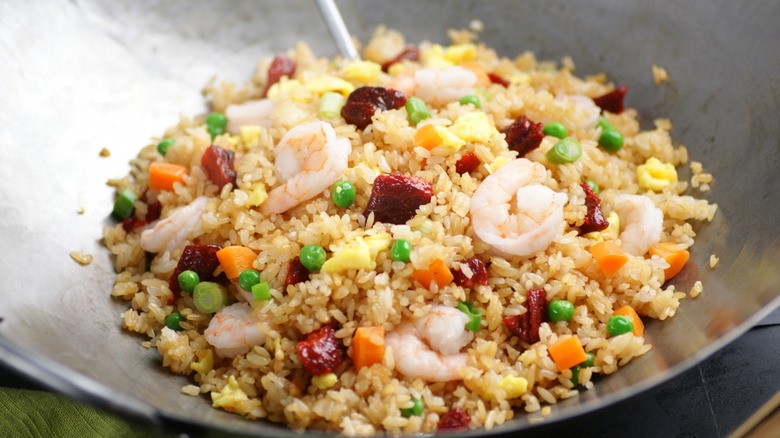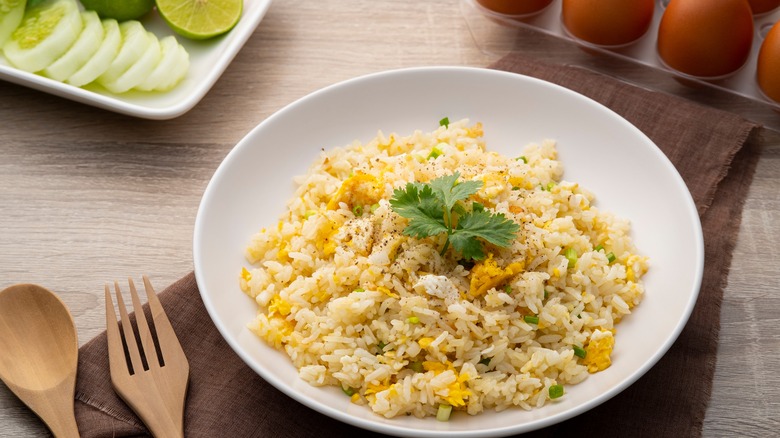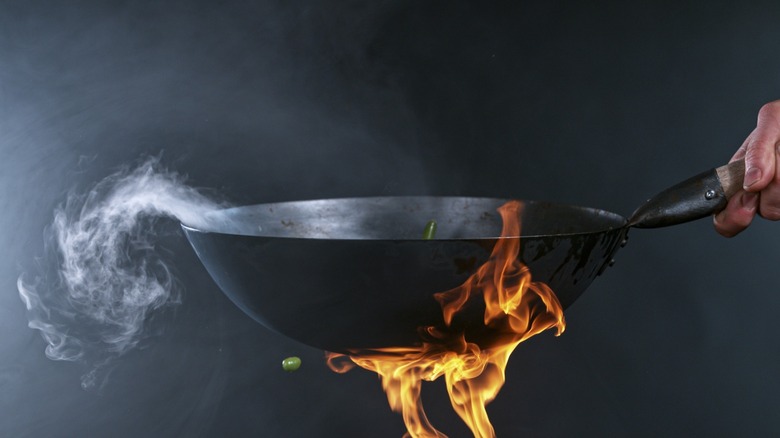For The Best Egg Fried Rice Of Your Life, Start With A Hot Wok
Egg fried rice is a wonderfully straightforward but versatile dish, able to adapt to a seemingly endless list of ingredients and ready to enjoy for lunch, dinner, or even breakfast (there is egg inside after all!). There aren't too many strict guidelines for cooking the dish as long as you remember one big tip for cooking with a wok: always preheat it before preparing the meal. This will make for the fluffiest, moistest eggs and will protect your other fried goods from sticking to the pan.
Adding oil to a hot wok to season it is a tried and true cooking method that has existed for so long that there's a Cantonese word for it: "longyau." This refers to the practice of "hot wok, cold oil," in which chefs add plenty of room-temperature cooking oil to a preheated wok to make the dish perfect. When doing so, you should coat and season the entire pan, creating a nonstick surface while also imparting more flavor to the stir fry. The oil should ideally be so hot that the wok starts smoking, at which point you should dump the batch out and pour in a new batch of oil, this time used for actually cooking the food.
A hot wok ensures eggs cook properly
Preheating a wok in this manner is suitable for any recipe, but it's especially important when working with delicate eggs. Yolks are quick to cook and thus quick to burn, so pouring them over a fiery skillet will immediately make them solidify. Removing the scrambled eggs right after they've become fluffy is an important step to make sure they don't burn. Take them out of the wok and put in a separate bowl while you cook the other components of the dish. Later, you can add even more egg to the mixture of rice, protein, and veggies before topping it all off with the first round of scrambled eggs.
Although you should preheat a wok over high heat, it's best to dial down the flame to a medium-high setting after the initial oil has coated the surface, so the egg and additional ingredients don't burn. (The wok is already hot, and the oil has already done its job.)
A helpful rule to check for the appropriate wok heat is to throw a bit of water into the pan. If it immediately starts to fizzle, then your egg should do the same and you're good to go, ensuring the whole process will be a stick-free affair.
The art of seasoning a wok
Although cast-iron woks exist, most of them are made out of a more lightweight carbon steel. Both are naturally non-stick surfaces, but they each have different seasoning processes. Unlike skillets that slowly bathe in the oven's heat, carbon steel woks are quickly seasoned over high heat. The wok should take on a blueish tint as it's heated up, and the oil should create a layer of patina that should get thicker over time.
Seasoning a wok this way not only helps create a nonstick surface, it also adds flavor to whatever you're cooking. Adding oil before a wok is properly heated up will break down the fat molecule in the oil, making whatever you're cooking taste slightly burnt. On the contrary, quickly coating the surface of a wok that's already steaming hot will add a protective layer that will absorb the flavors of what ingredients you add next.
It's also important to remember to use an oil with a high smoke point such as vegetable oil, peanut oil, soybean oil, or grapeseed oil. It may be tempting to use sesame oil considering you're probably working with Asian recipes, but this should only come into the dish later to flavor whatever is cooked already because it burns much too quickly to season your wok; this is true of olive oil as well. The best part of this easy standard practice is that, over time, a well-seasoned wok will only get easier to cook with and create even tastier dishes.



